From carbon to iron
Evolution of Greek Inks from Hellenistic Times to Late Antiquity
2022–2025
RFK02

Recent research on the technology of ink production has emphasized the role of the period ranging from the Hellenistic to the early-Byzantine time for the development of iron-gall inks. The composition of inks from that time varies greatly, and a growing number of examples of carbon inks with added copper and/or iron are being reported alongside the traditional carbon inks. From the Hellenistic period emerge both the earliest analysed examples of inks with metal additives and the earliest ink recipes mentioning metals.
This project investigates Greek inks from the Hellenistic to early Byzantine period. It aims to further our understanding of the development of iron-gall ink and its use during that period by combining non-destructive material analysis of inks from various collections in Europe with the extensive study of Antique and Byzantine written sources on recipes, price, availability, and trade of materials used for ink making. The project’s corpus consists mostly of dated and located administrative documents from Hellenistic and Roman Egypt, so that the geographical and chronological spread of different ink types can be tracked. With the help of palaeographers, different scribes working on a single document, or scribes whose handwriting is present across several documents are identified, and the inks they used are compared. A special emphasis is put on multilingual manuscripts in order to examine possible correlations between language and ink composition.
People
Project lead: Olivier Bonnerot
